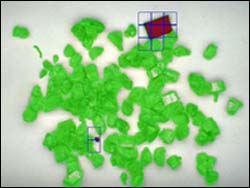Here you can find a summary of innovations in the fields of information and data processing and up-to-date developments on IT equipment and hardware.
This area covers topics such as IT services, IT architectures, IT management and telecommunications.

Radio frequency identification (RFID) chips implanted into human beings hold the promise of improving patient care, particularly in emergency settings, but only after privacy questions are addressed, according to a Beth Israel Deaconess Medical Center (BIDMC) physician who has a chip implanted in his arm.
Writing in the July 28 edition of the New England Journal of Medicine, John Halamka, MD, chief information officer at BIDMC and Harvard Medical School and an emergency room physi

Although metal detectors help commercial food processors keep metal fragments from ending up in finished products, these detectors can’t identify plastic and other foreign objects.
And as plastic becomes more widespread, used in everything from conveyor belts to latex gloves, plastic contamination is a growing concern for many food processing operations.
For the past year, John Stewart, a research engineer at the Georgia Tech Research Institute, has been leading a

A team led by the Institute of Food Research has completed a 2-year study of food choices made at a North London school, to be published on Thursday. Scientists tested the viability of using “smart card” technology to monitor pupils’ mealtime choices.
Project leader Dr Nigel Lambert said: “School dinners are currently a highly political and emotive social issue. The government has pledged to tackle menus, but measuring children’s eating habits at school is fraught with difficultie

“Being nominated for the Descartes Prize is very gratifying; it’s an important recognition of our work,” says Teresa Gutierrez, coordinator of a short-listed project competing for the Descartes Prize for outstanding scientific work by a multinational team of researchers.
Involving six partners from four European countries, the IST GRAB project developed a system to allow blind and visually impaired people to access three-dimensional computer graphics through the senses of touch and

A textile marking system developed at Oak Ridge National Laboratory that encodes information invisible to the naked eye could save the U.S. millions of dollars in revenue lost each year to counterfeiters and violators of trade laws.
While Mexican, Caribbean, African and Central American firms commonly use raw materials produced in the United States – and receive exemption from certain import tariffs – some manufacturers routinely falsify country-of-origin certification to avoid p

The World Wide Web allows us to access masses of information, both textual and visual. Conducting a search for images by entering a few keywords into a search engine is simple, but such a search often results in hundreds and sometimes thousands of images being returned. Many of these images will be totally unrelated to the subject of the search as current image searching is largely based on words rather than image content.
Oxford Inventors collaborating with colleagues at California In